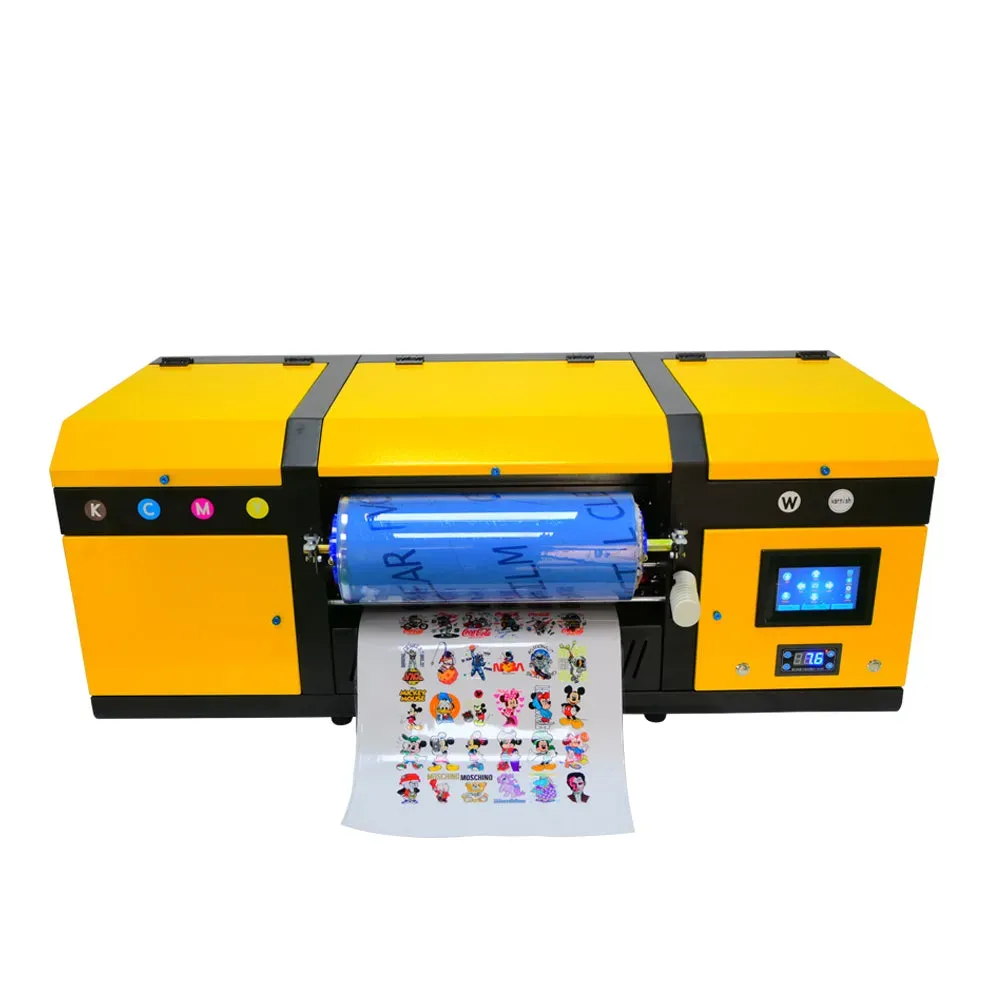In the realm of contemporary printing solutions, the UV DTF printer stands out as a remarkable innovation, combining the best features of UV printing technology and Direct to Film (DTF) processes. Whether you’re a small business owner or a large-scale print operation, selecting the best UV DTF printer can significantly enhance your projects’ vibrancy and detail. This unique technology utilizes ultraviolet light to cure inks instantly, resulting in eye-catching prints that adhere well to various substrates, from textiles to rigid materials. With an array of options available, understanding how to choose a UV printer based on essential features and efficiency can be overwhelming. This guide will empower you with the knowledge to navigate through the key considerations to find the perfect UV DTF printing solution that aligns with your business goals.
When exploring advanced printing technology, many enthusiasts and professionals refer to machines like the UV Direct-to-Film printer, which revolutionizes the way we produce high-quality images. This innovative equipment integrates UV curing processes that deliver exceptional print quality and durability, making it ideal for a range of applications, including custom garment decoration and promotional items. As buyers delve into selecting suitable options, they often seek out the most efficient UV printing devices that offer unique features geared towards boosting productivity. Understanding the complexities of DTF print technology, alongside other functional aspects, becomes crucial in determining the right fit for specific printing needs. Utilizing this comprehensive DTF printing guide will ensure that you are well-equipped to make an informed investment.
Understanding UV Printing Technology
UV printing technology utilizes ultraviolet light to cure ink as it is applied to the substrate, making it a groundbreaking advancement in the printing industry. This process allows for immediate drying, leading to sharp and vibrant images that are impervious to smudges and scratches. Because the ink doesn’t absorb into the material but rather sits on top, UV prints can exhibit exceptional depth and clarity, characteristics that traditional printing methods cannot replicate. As a result, UV printers are becoming the go-to choice for businesses that prioritize quality and durability.
In addition to delivering high-quality output, UV printing is also incredibly versatile, catering to a wide array of materials including glass, metal, wood, and plastics. This flexibility empowers businesses to broaden their offerings, serving various industries from signage and promotional products to apparel and packaging. Furthermore, the eco-friendliness of UV inks, which emit fewer volatile organic compounds (VOCs), aligns with the growing demand for sustainable practices, making UV printing a wise choice for modern enterprises.
Choosing Features of the Best UV DTF Printer
When selecting the best UV DTF printer, several features warrant careful attention. Key specifications include print resolution, speed, and ink technology. For instance, a minimum resolution of 600 dpi is essential for achieving professional-grade prints, while higher speeds enable higher productivity, allowing businesses to complete more projects in less time. Additionally, the printer should be capable of producing a wide color gamut to ensure vibrant and accurate color reproduction. A printer equipped with advanced software for precise color management can enhance the overall quality of the prints.
Moreover, the ink technology employed in the UV DTF printer is crucial. High-quality UV inks not only provide brilliant colors but also offer exceptional adhesion, allowing prints to withstand various environmental conditions. Choosing a printer that supports eco-friendly inks will also benefit businesses looking to enhance their sustainability profile. Ultimately, understanding these features will empower businesses to make an informed decision that aligns with their operational needs.
The Importance of Material Compatibility in UV DTF Printers
Material compatibility is a critical factor to consider when purchasing a UV DTF printer. With the ability to print on various substrates, these printers can significantly expand your services and influence your customer satisfaction levels. For businesses that wish to diversify their offerings, a printer capable of handling materials such as textiles, plastics, and even wood and metal can open up a plethora of new markets. This kind of versatility means that you can fulfill a wider range of client requirements without the need to invest in multiple machines.
Furthermore, printers with broader material compatibility tend to be more cost-effective in the long run. By eliminating the need for specialty printers for each substrate type, businesses can simplify their workflow, reduce overhead costs, and increase efficiency. Therefore, when evaluating the options, ensure that the printer supports the range of materials you intend to work with, ensuring it matches your business goals and market demand.
Evaluating Cost of Operation for UV DTF Printers
When deciding on the best UV DTF printer, evaluating the cost of operation should be at the forefront of the decision-making process. It’s essential to consider all ongoing costs associated with the printer, such as the price of inks, maintenance needs, and power consumption. High-quality inks may come at a premium, but they often result in better print quality and durability, which can justify the investment over time. Understanding these cost dynamics will enable businesses to balance quality with budget considerations effectively.
Additionally, the ease of maintenance can significantly affect overall operational costs. Printers that require frequent repairs or have a steep learning curve can lead to increased downtime and lost productivity. Selecting a UV DTF printer with user-friendly features and solid customer support can mitigate these risks, resulting in smoother operations and better financial outcomes. Ultimately, a thorough evaluation of operational costs will yield a more informed investment in the right printer for long-term success.
Recent Advances in UV DTF Printing Technology
The world of UV DTF printing has recently seen some remarkable advances that dramatically enhance both performance and environmental sustainability. Innovations such as automatic print head cleaning systems and advanced color management software are now commonplace in modern printers, ensuring that users can maintain high levels of output efficiency and quality with minimal effort. As technology continues to evolve, these enhancements pave the way for superior print quality, making UV DTF printers even more appealing for businesses seeking to stay competitive.
In addition, many manufacturers are beginning to adopt eco-friendly practices, creating UV inks that emit fewer harmful substances, thus reducing their environmental impact. With increased scrutiny on sustainability, opting for printers that prioritize eco-friendliness not only caters to the growing consumer demand for responsible practices but also positions your business as a forward-thinking entity in the marketplace. Keeping abreast of these technological advancements will ensure that businesses remain at the forefront of the industry while delivering high-quality products.
Tips for Selecting the Right Brand of UV DTF Printer
Selecting the right brand of UV DTF printer is pivotal to securing a reliable printing solution for your business. Some of the most respected manufacturers, such as Mimaki, Roland, and Epson, offer a variety of models designed to meet diverse needs and budgets. When researching brands, it is vital to consider their reputation in the industry, the support they provide, and the overall user satisfaction. Reading customer reviews and feedback will provide insight into the reliability and durability of their products.
Moreover, attending trade shows or direct consultations with representatives can shed light on the best models that fit your specific requirements. It is also beneficial to investigate warranty options and customer support services offered by different brands, as having access to knowledgeable assistance may be crucial in addressing potential operational issues. Ultimately, investing in a trusted brand will likely yield the best long-term results for your UV DTF printing operations.
Frequently Asked Questions
What are the key features to look for in the best UV DTF printer?
When searching for the best UV DTF printer, consider important features like print resolution (at least 600 dpi), color vibrancy, material compatibility, speed and efficiency, user-friendly interface, and economical cost of operation. These aspects will significantly impact your printing quality and overall productivity.
How does UV printing technology enhance the DTF printing process?
UV printing technology enhances the DTF printing process by using ultraviolet light to cure the ink instantly as it is printed. This results in vibrant colors, sharp images, and excellent adhesion to various substrates, making it ideal for high-quality output.
What materials can a UV DTF printer typically handle?
A UV DTF printer is versatile and can handle a wide range of materials including textiles, plastics, metals, glass, and more. This compatibility allows businesses to expand their offerings and cater to various printing applications.
How can I choose the right size of UV DTF printer for my workspace?
To choose the right size of UV DTF printer, assess your workspace dimensions and consider the scale of your projects. If you frequently produce larger prints, opt for a wide-format printer; else, a more compact model may suit your needs better.
What is the importance of ink technology in UV DTF printers?
Ink technology is crucial in UV DTF printers as high-quality UV inks offer durability, vibrancy, and excellent adhesion to surfaces. Additionally, eco-friendly inks are desirable as they comply with environmental standards while delivering superior printing results.
What are the ongoing costs associated with operating a UV DTF printer?
Ongoing costs for operating a UV DTF printer include ink, maintenance, and power consumption. Evaluating these costs against your budget is vital for determining your overall investment and ensuring profitability in your printing business.
| Key Point | Description |
|---|---|
| Print Quality | Look for high resolution (600 dpi minimum) and good color vibrancy to ensure professional-grade outputs. |
| Printer Size and Format | Consider your workspace and choose a printer size that fits, ensuring it can handle the media sizes needed for your projects. |
| Ink Technology | Opt for printers using durable, high-quality UV inks that are eco-friendly and compliant with safety standards. |
| Speed and Efficiency | Evaluate the printer’s speed measured in square feet per hour, crucial for high-volume printing tasks. |
| Material Compatibility | Ensure versatility to print on various substrates like textiles, plastics, metals, and glass, catering to diverse client needs. |
| Ease of Use | Choose printers with user-friendly interfaces and good customer support to improve operational efficiency. |
| Cost of Operation | Consider the overall cost of ownership, including maintenance, ink, and energy consumption relative to your budget. |
| Brand Reputation and Support | Select trusted brands with positive industry reviews and reliable after-sales support for continuous operation. |
Summary
A UV DTF printer can significantly impact your printing capabilities by providing high-quality output, broad substrate compatibility, and greater efficiency. As you assess your options, focus on key factors like print quality, ink technology, and ease of use. Investing in a capable UV DTF printer allows you to enhance your production workflow while ensuring vibrant and durable prints. By staying informed about the latest advancements and seeking reputable brands, you can make an optimal choice that meets your requirements.



